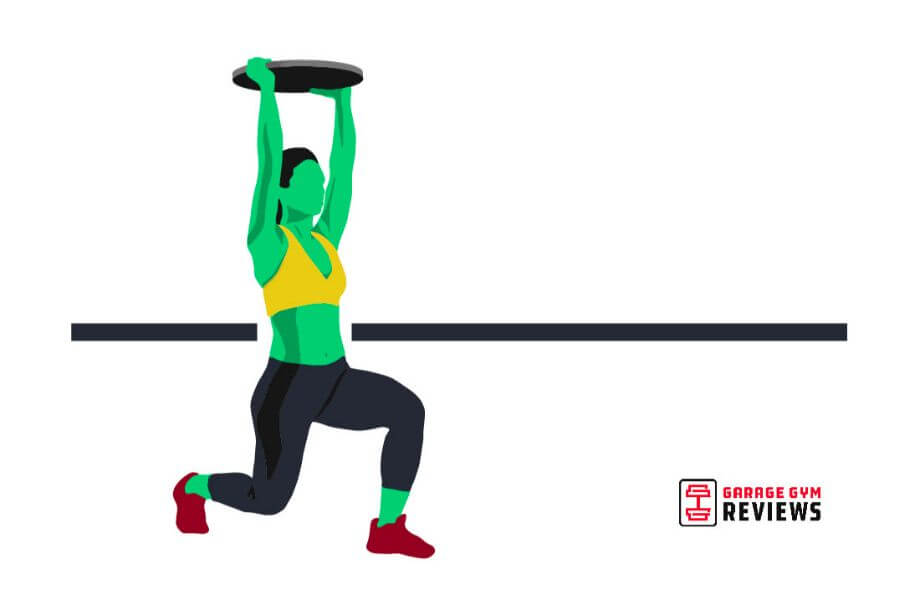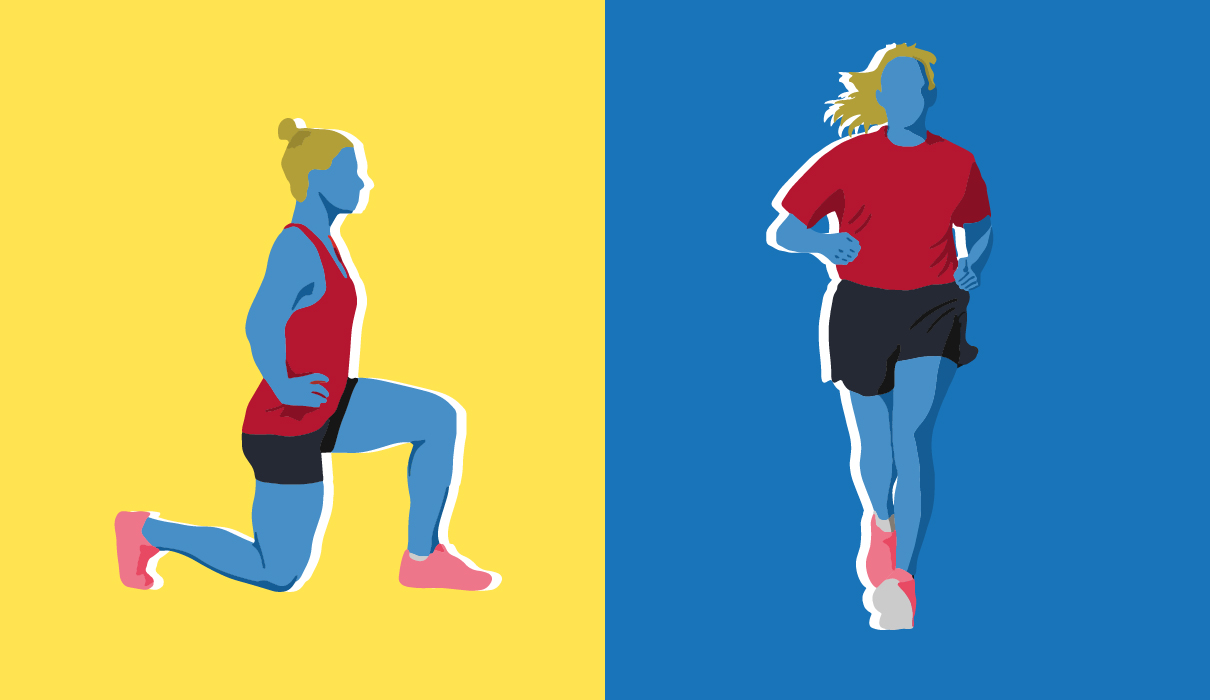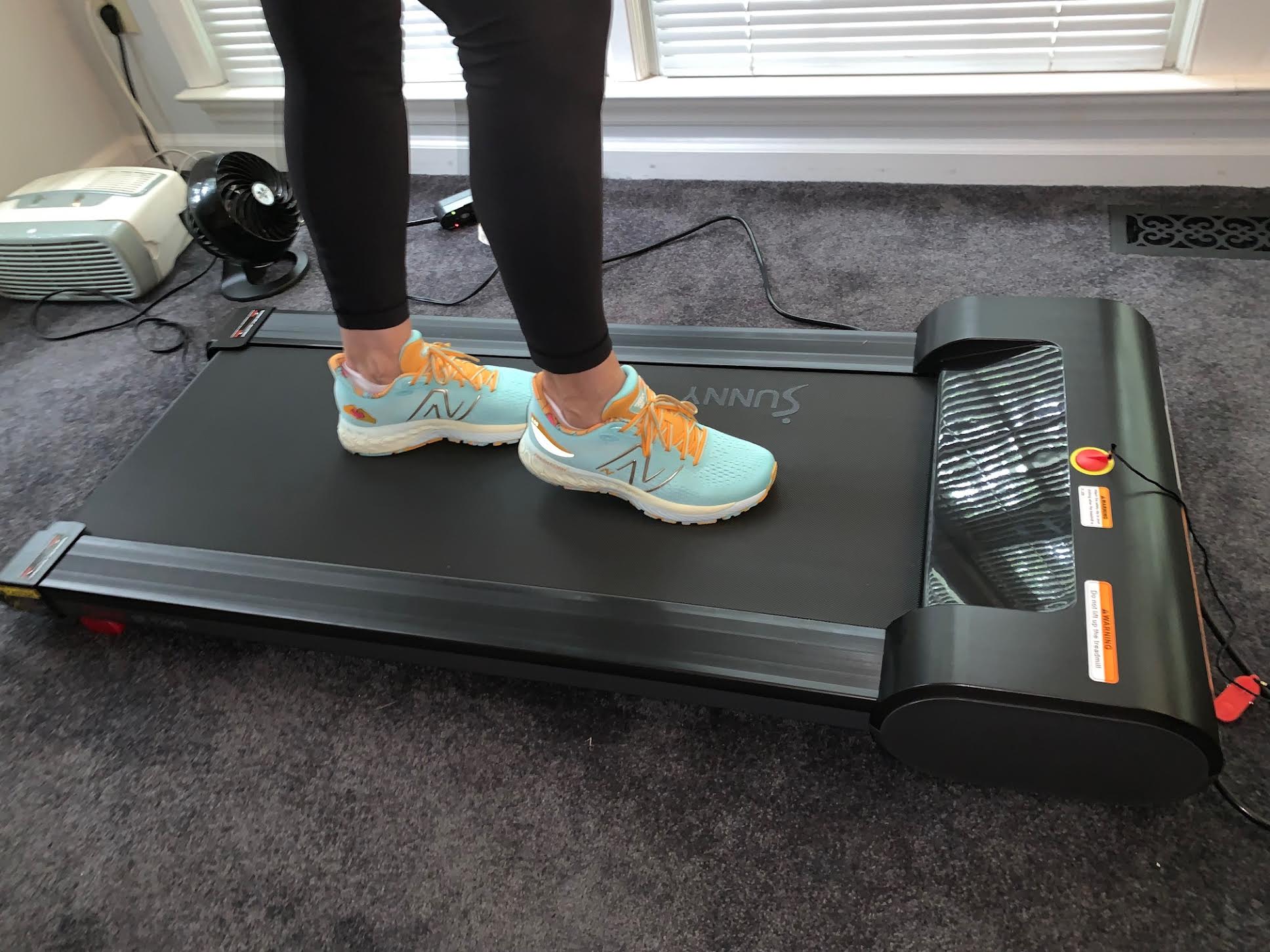Completing a half-marathon is a notable achievement. Let’s get you to the finish line!
Many people have dreams of crossing the finish line of a long-distance race, whether “long-distance” to you means a 5K, 10K, half-marathon, full marathon, or an ultra race. Here, we’ll focus on a very common bucket list item for cardio aficionados: the half-marathon.
In this guide, you’ll find several half-marathon training plan options, as well as info on how to fuel for your training and what to expect on the big day.
What to Expect During Your First Half-Marathon

I won’t sugarcoat it: Running a half-marathon is hard. Very hard. Even for experienced runners. As someone who has completed three half-marathons, I can tell you it remains difficult, especially if you’re the type who likes to achieve a new personal best at every race.
There are some funny and some not-so-funny things that come with the territory of long-distance racing. Take these training tips from Kate Meier, GGR Head of Content and marathoner-turned-Olympic-weightlifter:
“What I most remember from my first long-distance race are the NERVES. And also how those nerves would take the form of half a dozen nervous pees before the start. Advice: Know where the toilets are.”
“Training-wise, I wasn’t prepared to lose toenails, or all the gear and products that come with endurance, like a water bottle with a hand strap, hydration vest, energy gels, actual running shoes, anti-chafing sticks, etc. I thought I could do it with just my boring old gym shoes!” Kate adds.
“Also, expect to be bored. Half- and full-marathon training can be lonely, so I joined a running group, which made it SO FUN. We all targeted the same races, did speed work together, and tapered together.
“And the hunger—the hunger is real!”
We’ll dive into more details as we go through this guide, but here are a few additional starter tips from yours truly:
- Use your gear thoroughly before toeing the line. You do not—I repeat, do NOT—want to run a race with new shoes, a new running vest, or even a new pair of running sunglasses. Just don’t do it.
- Get your nutrition in check. Experiment with energy gels, bars, and chews to find out what works for you. Forcing down something foreign on the day-of could mean an unruly stomach, and then you’ll REALLY need to know where the port-a-potties are.
- Don’t skimp on products that make you comfortable, budget permitting. When I ran my first half-marathon, I thought, “Oh, I don’t need that,” about a lot of things, like fancy compressive running socks, anti-chafe products, and nice running clothes. I can tell you that after I lost a toenail I was no longer afraid to invest in the good stuff.
Half-Marathon Training Components

Here, we’ll cover all of the various components of successfully training for a half: different types of runs, cross-training, and recovery.
Speed Work
As the name suggests, speed work helps you get faster. Speed training sessions will be the shortest of your running workouts, aside from perhaps your easy runs. This type of session will typically take the form of interval training, ranging from sprint repeats to mile repeats.
Long Runs
Again, as the name implies, long runs are…long. Long runs will make up a good portion of your overall training and they are super important—a long run is when you push yourself to increase your mileage and work on smart pacing. You can’t run 13 miles without first running nine, 10, 11, and 12!
Tempo Runs
Tempo runs are arguably as important as long runs. They are shorter in distance but tougher in terms of pace. For a tempo run, you’ll choose a semi-challenging pace to a very challenging pace (depending on factors like recovery and mindset) for a given distance, and aim to maintain that pace for the entire run. You can choose paces for tempo runs with our pace chart and calculator below.
Fartlek Runs
A Fartlek run (yes, it’s a real word, and it roughly means “speed play”), is a fun type of run where you’re in control of the speed. Rather than setting a predetermined pace and holding it, on a Fartlek run you’ll make up intervals for yourself and run based on feel. This type of session is a great way to honor your body when you’re feeling tired but still need to train. An example of what you might do on a Fartlek run is jog until the next mailbox on your route, and then sprint to the following, and so forth.
Cross-Training and Strength Training

For runners, cross-training is anything that isn’t running. Cross-training can be another form of cardio, such as biking, rowing, swimming, or even walking a mile. However, most coaches encourage serious runners to engage in other forms of exercise, including yoga, bodyweight strength training, and lifting weights.
Lifting weights, even light weights, is extremely helpful for runners because it strengthens the muscles in the way running alone cannot. This increases your muscular endurance and gives you the power you need to push up long hills and the balance you need to stay stable and strong on steep declines. Strong muscles also protect the joints they surround, so strength training also offers an element of injury-proofing.
I want to drive this home: Many beginner runners neglect cross-training because they feel they need to run more. I’ve been guilty of this in the past. But once I began incorporating cross-training, specifically strength training, into my plans, my running pace became consistently faster and I felt stronger out on the pavement. You’ll find that your cross-training days become super important to meeting your half-marathon goals.
RELATED: Biking vs Walking
Workout Recovery and Mobility
Lack of recovery is the downfall of many runners. Workout recovery isn’t one singular action, but instead a collection of actions and habits that support long-term performance. Prioritizing recovery can mean:
- Eating enough nutritious foods and drinking enough fluids
- Getting enough sleep (and implementing ways to get quality sleep)
- Stretching, foam rolling, using a massage tool, or engaging in other methods of soft tissue mobilization
- Resting (yes, meaning, doing nothing)
Ensuring that your training plan includes rest and recovery means you manage your risk of overtraining syndrome, which can have some pretty harsh symptoms.
Half-Marathon Training Schedule
Here you’ll find three different half-marathon training plans: one for beginners, one for intermediate runners, and one for advanced runners. Each is different, progressive, and specific and includes all of the elements you learned above. Your weekly mileage will vary depending on which plan you choose, but ultimately, you’ll work your way toward your first or a faster race.
Couch to Half-Marathon Training Program
First we took you from couch to 5K, now we’re taking you from couch to 13.1. Here’s a complete couch to half-marathon training plan that spans six months and contains 5 training sessions per week: three run days and two cross-training days. Yes, if you stick to this plan, you can go from zero to 13.1 in 180 days.
Keep in mind that this plan is templatized, so you can customize what you do on a given day to meet your needs and availability—as long as you’re hitting all of the components each week, you’ll be able to cross the line.
12-Week Half-Marathon Training Plan
This 12-week training plan is intended for people who have some running experience but need a dedicated plan to keep them on track and to steadily build up their stamina, endurance, and pace.
6-Week Get Faster Half-Marathon Program
Designed for advanced runners, this short-and-sweet (meaning, short-and-brutal) training plan focuses heavily on speed and tempo work for athletes who have a solid base of endurance and stamina. The template leaves room for your long runs, cross-training, and recovery runs and complete rest days.
What to Know About Deloads
As you progress through your training, you’ll come across the term “deload” or “deload week” time and time again. Deloads are intentional, defined time periods of less work. Yep, that’s right—taking more time to rest on purpose will actually progress your training further.
Deload weeks during half-marathon training may still contain some light, short runs, but will focus heavily on stretching, walking, and other muscle recovery methods.
In all three of our plans above, you’ll find deload weeks to allow your body ample time to recover. During these weeks, it’s important to resist the temptation to run more or harder because you feel like you should. We’re here to tell you: Stop “should-ing” yourself and enjoy the down time!
Find Your Race Day Pace (Pace Calculator and Pace Chart)

Calculate Your Running Pace
Enter your stats in any 2 of the fields below to calculate the third.
If you’re not sure how to find your pace for race day, you can use our pace chart to help. It’s important not to go out of the gate too fast, no matter how excited you are about stepping over the start line. You don’t want all of your hard work to go to waste simply because you ran too fast at the start.
| Mile Pace | 5K | 10K | 10M | Half | 15M | 20M | Marathon |
| 5:00 | 15:32 | 31:04:00 | 50:00:00 | 1:05:33 | 1:15:00 | 1:40:00 | 2:11:06 |
| 5:05 | 15:48 | 31:35:00 | 50:50:00 | 1:06:38 | 1:16:15 | 1:41:40 | 2:13:17 |
| 5:10 | 16:03 | 32:06:00 | 51:40:00 | 1:07:44 | 1:17:30 | 1:43:20 | 2:15:28 |
| 5:15 | 16:19 | 32:37:00 | 52:30:00 | 1:08:49 | 1:18:45 | 1:45:00 | 2:17:39 |
| 5:20 | 16:34 | 33:08:00 | 53:20:00 | 1:09:55 | 1:20:00 | 1:46:40 | 2:19:50 |
| 5:25 | 16:50 | 33:39:00 | 54:10:00 | 1:11:01 | 1:21:15 | 1:48:20 | 2:22:01 |
| 5:30 | 17:05 | 34:11:00 | 55:00:00 | 1:12:06 | 1:22:30 | 1:50:00 | 2:24:12 |
| 5:35 | 17:21 | 34:42:00 | 55:50:00 | 1:13:12 | 1:23:45 | 1:51:40 | 2:26:23 |
| 5:40 | 17:36 | 35:13:00 | 56:40:00 | 1:14:17 | 1:25:00 | 1:53:20 | 2:28:34 |
| 5:45 | 17:52 | 35:44:00 | 57:30:00 | 1:15:23 | 1:26:15 | 1:55:00 | 2:30:45 |
| 5:50 | :18:07 | 36:15:00 | 58:20:00 | 1:16:28 | 1:27:30 | 1:56:40 | 2:32:57 |
| 5:55 | 18:23 | 36:46:00 | 59:10:00 | 1:17:34 | 1:28:45 | 1:58:20 | 2:35:08 |
| 6:00 | 18:38 | 37:17:00 | 1:00:00 | 1:18:39 | 1:30:00 | 2:00:00 | 2:37:19 |
| 6:05 | 18:54 | 37:48:00 | 1:00:50 | 1:19:45 | 1:31:15 | 2:01:40 | 2:39:30 |
| 6:10 | 19:10 | 38:19:00 | 1:01:40 | 1:20:50 | 1:32:30 | 2:03:20 | 2:41:41 |
| 6:15 | 19:25 | 38:50:00 | 1:02:30 | 1:21:56 | 1:33:45 | 2:05:00 | 2:43:52 |
| 6:20 | 19:41 | 39:21:00 | 1:03:20 | 1:23:02 | 1:35:00 | 2:06:40 | 2:46:03 |
| 6:25 | 19:56 | 39:52:00 | 1:04:10 | 1:24:07 | 1:36:15 | 2:08:20 | 2:48:14 |
| 6:30 | 20:12 | 40:23:00 | 1:05:00 | 1:25:13 | 1:37:30 | 2:10:00 | 2:50:25 |
| 6:35 | 20:27 | 40:54:00 | 1:05:50 | 1:26:18 | 1:38:45 | 2:11:40 | 2:52:36 |
| 6:40 | 20:43 | 41:25:00 | 1:06:40 | 1:27:24 | 1:40:00 | 2:13:20 | 2:54:48 |
| 6:45 | 20:58 | 41:57:00 | 1:07:30 | 1:28:29 | 1:41:15 | 2:15:00 | 2:56:59 |
| 6:50 | 21:14 | 42:28:00 | 1:08:20 | 1:29:35 | 1:42:30 | 2:16:40 | 2:59:10 |
| 6:55 | 21:29 | 42:59:00 | 1:09:10 | 1:30:40 | 1:43:45 | 2:18:20 | 3:01:21 |
| 7:00 | 21:45 | 43:30:00 | 1:10:00 | 1:31:46 | 1:45:00 | 2:20:00 | 3:03:32 |
| 7:05 | 22:00 | 44:01:00 | 1:10:50 | 1:32:51 | 1:46:15 | 2:21:40 | 3:05:43 |
| 7:10 | 22:16 | 44:32:00 | 1:11:40 | 1:33:57 | 1:47:30 | 2:23:20 | 3:07:54 |
| 7:15 | 22:31 | 45:03:00 | 1:12:30 | 1:35:03 | 1:48:45 | 2:25:00 | 3:10:05 |
| 7:20 | 22:47 | 45:34:00 | 1:13:20 | 1:36:08 | 1:50:00 | 2:26:40 | 3:12:16 |
| 7:25 | 23:03 | 46:05:00 | 1:14:10 | 1:37:14 | 1:51:15 | 2:28:20 | 3:14:27 |
| 7:30 | 23:18 | 46:36:00 | 1:15:00 | 1:38:19 | 1:52:30 | 2:30:00 | 3:16:38 |
| 7:35 | 23:34 | 47:07:00 | 1:15:50 | 1:39:25 | 1:53:45 | 2:31:40 | 3:18:50 |
| 7:40 | 23:49 | 47:38:00 | 1:16:40 | 1:40:30 | 1:55:00 | 2:33:20 | 3:21:01 |
| 7:45 | 24:05:00 | 48:09:00 | 1:17:30 | 1:41:36 | 1:56:15 | 2:35:00 | 3:23:12 |
| 7:50 | 24:20:00 | 48:40:00 | 1:18:20 | 1:42:41 | 1:57:30 | 2:36:40 | 3:25:23 |
| 7:55 | 24:36:00 | 49:12:00 | 1:19:10 | 1:43:47 | 1:58:45 | 2:38:20 | 3:27:34 |
| 8:00 | 24:51:00 | 49:43:00 | 1:20:00 | 1:44:53 | 2:00:00 | 2:40:00 | 3:29:45 |
| 8:05 | 25:07:00 | 50:14:00 | 1:20:50 | 1:45:58 | 2:01:15 | 2:41:40 | 3:31:56 |
| 8:10 | 25:22:00 | 50:45:00 | 1:21:40 | 1:47:04 | 2:02:30 | 2:43:20 | 3:34:07 |
| 8:15 | 25:38:00 | 51:16:00 | 1:22:30 | 1:48:09 | 2:03:45 | 2:45:00 | 3:36:18 |
| 8:20 | 25:53:00 | 51:47:00 | 1:23:20 | 1:49:15 | 2:05:00 | 2:46:40 | 3:38:29 |
| 8:25 | 26:09:00 | 52:18:00 | 1:24:10 | 1:50:20 | 2:06:15 | 2:48:20 | 3:40:40 |
| 8:30 | 26:24:00 | 52:49:00 | 1:25:00 | 1:51:26 | 2:07:30 | 2:50:00 | 3:42:52 |
| 8:35 | 26:40:00 | 53:20:00 | 1:25:50 | 1:52:31 | 2:08:45 | 2:51:40 | 3:45:03 |
| 8:40 | 26:56:00 | 53:51:00 | 1:26:40 | 1:53:37 | 2:10:00 | 2:53:20 | 3:47:14 |
| 8:45 | 27:11:00 | 54:22:00 | 1:27:30 | 1:54:42 | 2:11:15 | 2:55:00 | 3:49:25 |
| 8:50 | 27:27:00 | 54:53:00 | 1:28:20 | 1:55:48 | 2:12:30 | 2:56:40 | 3:51:36 |
| 8:55 | 27:42:00 | 55:24:00 | 1:29:10 | 1:56:54 | 2:13:45 | 2:58:20 | 3:53:47 |
| 9:00 | 27:58:00 | 55:55:00 | 1:30:00 | 1:57:59 | 2:15:00 | 3:00:00 | 3:55:58 |
| 9:05 | 28:13:00 | 56:26:00 | 1:30:50 | 1:59:05 | 2:16:15 | 3:01:40 | 3:58:09 |
| 9:10 | 28:29:00 | 56:58:00 | 1:31:40 | 2:00:10 | 2:17:30 | 3:03:20 | 4:00:20 |
| 9:15 | 28:44:00 | 57:29:00 | 1:32:30 | 2:01:16 | 2:18:45 | 3:05:00 | 4:02:31 |
| 9:20 | 29:00:00 | 58:00:00 | 1:33:20 | 2:02:21 | 2:20:00 | 3:06:40 | 4:04:43 |
| 9:25 | 29:15:00 | 58:31:00 | 1:34:10 | 2:03:27 | 2:21:15 | 3:08:20 | 4:06:54 |
| 9:30 | 29:31:00 | 59:02:00 | 1:35:00 | 2:04:32 | 2:22:30 | 3:10:00 | 4:09:05 |
| 9:45 | 30:18:00 | 1:00:35 | 1:37:30 | 2:07:49 | 2:26:15 | 3:15:00 | 4:15:38 |
| 10:00 | 31:04:00 | 1:02:08 | 1:40:00 | 2:11:06 | 2:30:00 | 3:20:00 | 4:22:11 |
| 10:15 | 31:51:00 | 1:03:41 | 1:42:30 | 2:14:22 | 2:33:45 | 3:25:00 | 4:28:45 |
| 10:30 | 32:37:00 | 1:05:15 | 1:45:00 | 2:17:39 | 2:37:30 | 3:30:00 | 4:35:18 |
| 10:45 | 33:24:00 | 1:06:48 | 1:47:30 | 2:20:56 | 2:41:15 | 3:35:00 | 4:41:51 |
| 11:00 | 34:11:00 | 1:08:21 | 1:50:00 | 2:24:12 | 2:45:00 | 3:40:00 | 4:48:24 |
| 11:15 | 34:57:00 | 1:09:54 | 1:52:30 | 2:27:29 | 2:48:45 | 3:45:00 | 4:54:58 |
| 11:30 | 35:44:00 | 1:11:27 | 1:55:00 | 2:30:45 | 2:52:30 | 3:50:00 | 5:01:31 |
| 11:45 | 36:30:00 | 1:13:01 | 1:57:30 | 2:34:02 | 2:56:15 | 3:55:00 | 5:08:04 |
| 12:00 | 37:17:00 | 1:14:34 | 2:00:00 | 2:37:19 | 3:00:00 | 4:00:00 | 5:14:38 |
What to Eat While Training for a Half-Marathon
When it comes to running long-distance races, fueling yourself is half the battle. Running fuel is so important: It’s your key to prevent “bonking,” a runner’s colloquial term for hitting a wall or experiencing a sudden and severe dip in energy. Usually, such dips can be attributed to low blood sugar and a loss of glycogen stores.
It’s important to eat and drink to support your energy expenditure during your training and on race day.
While we have a full guide to running fuel, we’ll recap a few basics here:
- Complex carbohydrates and fats support long-term energy and are important to consume on a regular basis if you are running regularly. They are particularly helpful the night before and up to a few hours before your run or race.
- Proteins primarily support muscle recovery and growth, but are also extremely important for hormonal balance, which is crucial when you are expending so much energy day to day.
- Simple carbohydrates and sugars support short-term energy. Consume these anywhere from one hour to a few minutes before your run and intermittently throughout long runs and races.
- Fluids and electrolytes are crucial for hydration and rehydration. If you are training for a half-marathon multiple days per week, it’s important to pay close attention to your daily hydration levels. During long runs and on race day, make sure you are replenishing with electrolyte solutions at regular intervals.
Half-Marathon FAQs
How long does a half-marathon take?
A half-marathon can take anywhere from about one hour to several hours, depending on one’s fitness level and running pace. Elite runners can log 13.1 miles in 90 minutes or less; strong runners can complete a half-marathon in 90 minutes to two hours; intermediate runners may need two to 2.5 hours; and first-timers can expect to cross the finish line between 2.5 and 3.5 hours. Walkers will need around four hours.
What is the best half-marathon for beginners?
There are so many half-marathon routes around the world that we couldn’t possibly pinpoint one as the best for all beginner runners. As a rule of thumb, though, running is easier on flat terrain at low altitudes and in mild climates. A flat course in a sea-level location with low humidity and temperatures between 60 and 70 degrees would be a dream come true for many runners! Tougher terrain and hot or cold weather—not to mention rain, snow, ice, and humidity—can impact your half-marathon pace in a big way.
How many times per week should you run to prepare for a half-marathon?
This depends heavily on your training availability and how you structure your program. Anywhere from three days per week up to six days will work, depending on a variety of factors, such as volume, types of runs, cross-training, and recovery.
What is a good half-marathon time for a beginner?
A typical finishing time for a first-time beginning runner is between 2.5 to 3.5 hours. A “good” time would be on the lower end of that range, however, we think anyone who finishes a half-marathon in any capacity is quite awesome!
How can I improve my half-marathon race pace?
Whether you’re a new runner or an advanced athlete, you can crush your next half-marathon by completing a variety of training runs, perfecting your running form, ensuring a warmup precedes each run, paying attention to your heart rate during training sessions, and by following a variety of other half-marathon tips provided in this guide.







